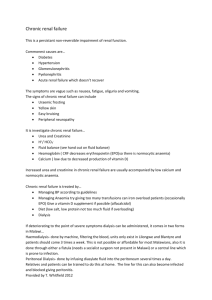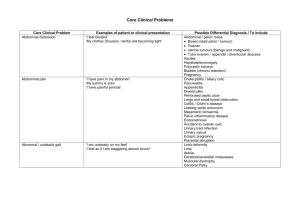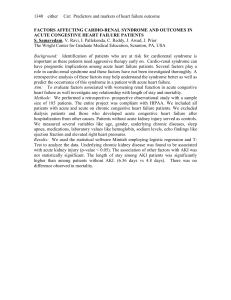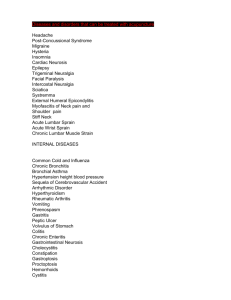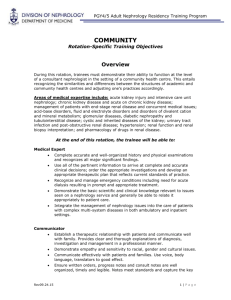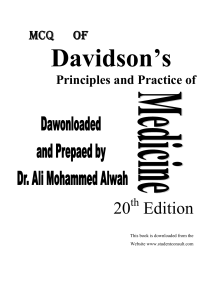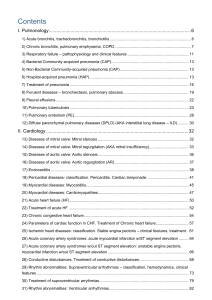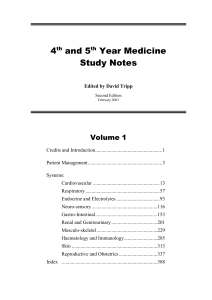EXAMINATION TOPICS Toxicology 1. Iatrogen diseases 2
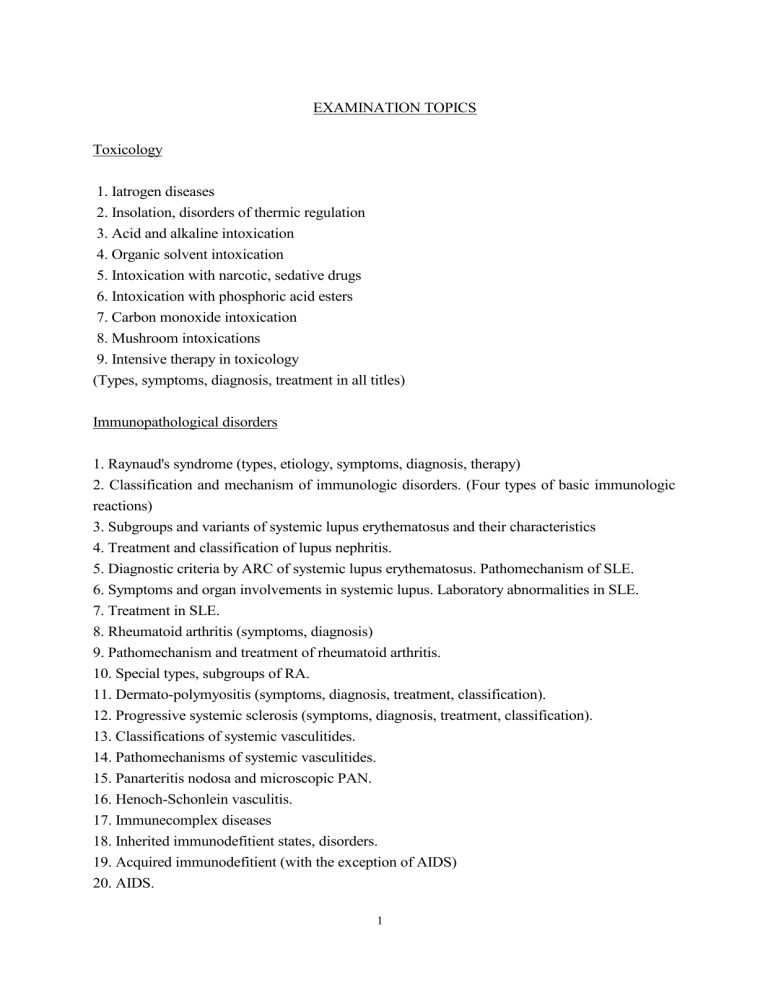
Toxicology
EXAMINATION TOPICS
1. Iatrogen diseases
2. Insolation, disorders of thermic regulation
3. Acid and alkaline intoxication
4. Organic solvent intoxication
5. Intoxication with narcotic, sedative drugs
6. Intoxication with phosphoric acid esters
7. Carbon monoxide intoxication
8. Mushroom intoxications
9. Intensive therapy in toxicology
(Types, symptoms, diagnosis, treatment in all titles)
Immunopathological disorders
1. Raynaud's syndrome (types, etiology, symptoms, diagnosis, therapy)
2. Classification and mechanism of immunologic disorders. (Four types of basic immunologic reactions)
3. Subgroups and variants of systemic lupus erythematosus and their characteristics
4. Treatment and classification of lupus nephritis.
5. Diagnostic criteria by ARC of systemic lupus erythematosus. Pathomechanism of SLE.
6. Symptoms and organ involvements in systemic lupus. Laboratory abnormalities in SLE.
7. Treatment in SLE.
8. Rheumatoid arthritis (symptoms, diagnosis)
9. Pathomechanism and treatment of rheumatoid arthritis.
10. Special types, subgroups of RA.
11. Dermato-polymyositis (symptoms, diagnosis, treatment, classification).
12. Progressive systemic sclerosis (symptoms, diagnosis, treatment, classification).
13. Classifications of systemic vasculitides.
14. Pathomechanisms of systemic vasculitides.
15. Panarteritis nodosa and microscopic PAN.
16. Henoch-Schonlein vasculitis.
17. Immunecomplex diseases
18. Inherited immunodefitient states, disorders.
19. Acquired immunodefitient (with the exception of AIDS)
20. AIDS.
1
21. Hypergammaglobulinemia.
22. Steroid treatment (indications, side effects, dose of equivalence, mechanism of action).
23. Immunosuppressive therapy (principles, products, side effects)
24. Non-differentiated collagenous disease.
25. Pregnancy in systemic lupus erythematosus. Importance of antiphospholipid antibodies.
Antiphospholipid syndromes.
26. Treatment of vasculitides.
27. Wegener's granulomatosis.
28. Immunstimulation (possibilities)
29. Tumor immunology (tumor associated antigens, immuntherapy in cancer)
30. Importance of histocompatibility antigens.
31. Renal transplantation (indications, acute and chronic rejections, treatment)
32. Transplantation immunology (organ and bone marrow transplantation)
33. Mixed connective tissue disease (MCTD)
34. Sjogren's disease
35. Characteristics of autoimmune disorders in general.
36. MHC and diseases (associations).
37. Therapeutic use of monoclonal antibodies.
38. Polymyalgia rheumatica.
39. Behcet disease.
Infectious diseases
1.
2.
3.
4.
Flu
Mumps
Shingles (Herpes zooster)
Symptoms of Coxsackie virus infection
5.
6.
7.
8.
9.
Parrot fever (Psittacosis, ornithosis)
Meningitis. Diseases caused by Meningococcus bacteria
Typhus
Salmonella infection
Shigella infection
10. Cholera
11. Tularemia
12. Brucella infection
13. Lockjaw (Tetanus)
14. Leptospira infection
15. Mycotic diseases
16. Intermittent fever (Malaria)
17. Amoeba infection
18. Toxoplasma infection
19. Tenia infection (Helminthiasis)
2
20. Ascaris lumbricoides caused disease
21. Oxyuris caused disease
22. Trichinella infection
23. Leprosy
24. Leishmania caused infection
25. Tripanosoma cruzii infection
26. Filharia infection
27. Schistosoma disease
28. Rabies
29. Septicemia. Septic shock. Pathomechanism and therapy of septic shock syndrome
30. Lyme’s disease
31. Echinococcus infection
Pulmonary diseases
1. Dust inhalation, pneumoconiosis
2. Bronchial asthma
3. Acute and chronic bronchitis
4. Emphysema
5. Bacterial pheumonia
6. Viral pneumonia.
7. Atypical pneumonia.
8. Pulmonary abscess, gangrena and bronchiectasia
9. Pulmonary sarcoidosis
10. Pulmonary fibrosis
11. Bronchial cancer
12. Pulmonary congestion and oedema
13. Pulmonary embolism
14. Pleuritis
15. Pneumothorax. Mediastinal diseases
16. Acute respiratory distress syndrome (ARDS)
Cardiovascular diseases
1. Normal ECG. Analysis of ECG in the 12 leads.
2. Infective endocarditis
3. Myocarditis
4. Rheumatic carditis
5. Acute and chronic cor pulmonale
6. Hypercirculatory syndrome. Neurosis cordis.
3
7. Ischemic heart disease (etiology, pathogenesis, risk factors, symptoms, differential diagnosis, therapy, prevention)
8. Coronary disease. Angina pectoris. Classification.
9. Treatment of angina.
10. Indications for coronarography.
11. Basic concept of fibrinolysis, systemic thrombolysis.
12. Heart failure in endocrine and metabolic diseases (thyreotoxicosis, myxedema, diabetes, amyloidosis, liver diseases, etc.)
13. Myocardial infarction (etiology, pathogenesis, location, symptomes)
14. Myocardial infarction (clinical symptoms, ECG findings, laboratory abnormalities).
15. Myocardial infarction (complications)
16. Treatment of myocardial infarction (drugs, rehabilitation)
17. Side effects of antihypertensive drugs
18. Pathogenesis of valve diseases. Mitral stenosis. Mitral regurgitation.
19. Diseases of the aortic valve
20. Combined mitral and aortic valve diseases
21. Arrhythmias (ECG, etiology, treatment)
22. Blocks (ECG, etiology, treatment)
23. Pericarditis
24. Congenital heart diseases
25. Congestive heart failure (symptoms, etiology)
26. Treatment of congestive heart failure
27. Functional staging of heart failure.
28. Shock. Collapses.
29. Epidemiology and risk factors of cardiovascular diseases
30. Hypertension
31. Epidemiology of cardiovascular diseases.
32. Risk factors in cardiovascular diseases.
33. Classification and mechanism of hypertension.
34. Acute situations in patients with hypertension. Hypertension encephalopathy.
35. Hypertensive cardiomyopathy.
36. Antihypertensive therapy.
37. Side effects of entihypertensive therapy.
38. Pregnancy and hypertension.
39. Indications and contraindications in the treatment of hypertension.
40. Development of atherosclerosis (theory)
41. Atheresclerosis obliterans
42. Obliterative thrombangiitis (Buerger's disease)
4
43. Peripheral vascular disease.
44. Symptoms of arterial occlusion.
45. Symptoms and etiology of arterial embolism and occlusion.
46. Aortic aneurysms
47. Deep venous thrombosis (symptoms, etiology, diagnosis)
48. Treatment of deep venopus thrombosis.
49. Pulmonary embolism ( diagnosis and treatment)
50. Classification of primary cardiomyopathies.
51. Atrial fibrillation (etiology, ECG, treatment)
52. Anticoagulant therapy (indications, types, laboratory monitoring)
53. Varicositas. Superficial phlebitis.
54. Cardiopulmonary resuscitation
55. Stable (effort) and instable angina (characteristics, classification)
56. Coronary artery bypass
Renal disorders
1. Diagnostic tests
2. Renal syndromes
3. Acute and chronic pyelonephritis
4. Acute and chronic glomerulonephritis
5. Autoimmune renal diseases
6. Pregnancy and the kidneys
7. Nephrotic syndrome
8. Renal failure in infectious, diabetic nephropathy, metabolic disorders. Renal failure caused by drugs
9. Interstitial nephritis (CPD).
10. Renal tuberculosis
11. Urolithiasis
12. Renal tumors and cysts
13. Acute renal failure
14. Chronic renal failure
15. Acute and chronic cystitis, cystopyelitis
16. Renal diseases caused by toxic agents and drugs
17. Dialysis and renal transplantation
18. Regular control of patients on chronic hemodialysis
5
Hematology
1. Anaemias
2. Iron deficiency anaemia
3. Megaloblastic anaemia
4. Hemolytic anaemia
5. Hereditary spherocytosis
6. Autoimmune hemolytic anaemia
7. Hemolysis caused by chemicals, infections
8. Polycythaemia
9. Agranulocytosis
10. Aplastic anaemia
11. Bone marrow transplantation
12. Infectious mononucleosis
13. Acute leukemia
14. Chronic myeloid leukemia
15. Myelofibrosis
16. Malignant lymphomas: classification
17. Hodgkin's disease
18. Non-Hodgkin's lymphoma
19. Chronic lymphocytic leukemia
20. Multiple myeloma
21. Waldenstrom's macroglobulinaemia
22. Classification of hemophilias
23. Thrombocytopenia, thrombocytopathia
24. Hemophilia
25. Thrombophilia
26. Vascular purpura
27. DIC
28. Splenic diseases
29. Treatment of hemolytic anaemia
30. Blood groups, modern hemotherapy
31. Myelodysplastic syndromes
32. Cytotoxic and supportive therapy
33. Erythropoetin and colony stimulating factor treatment (principles of therapy.
6
Rheumatology
1. Acute rheumatic polyarthritis
2. SPA (Morbus Bewchterew)
3. Reiter's syndrome
4. Osteoarthritis. Spondylosis. Discopathy, ischias.
5. Periarthritis humeroscapularis
6. Gout
7. Physiotherapy
8. Fibrositis. Dupuytren disease
9. Reactive arthritides
10. Diagnosis of rheumatic diseases
11. Juvenile chronic arthritis
12. Special forms of RA: Felty's and Caplan's syndrome, intermittent hydrarthrosis
13. Seronegative spondylarthritis
14. Psoriatic arthropathy
15. Infectious arthritis
16. Osteoporosis. Paget's disease
Gastroenterology
1. Esophagitis. Esophagus ulcer
2. Esophagus cancer
3. Other esophagus diseases
4. Laboratory diagnosis in gastroenterology
5. Gastric ulcer
6. Duodenal ulcer
7. Diseases after operation of the stomach
8. Gastrointestinal bleeding
9. Precancerotic states
10. Gastric cancer
11. Malabsorption
12. Crohn's disease
13. Idiopathic sprue
14. Colon irritable
15. Ulcerous colitis
16. Precancerosis in the colon
17. Colon cancer
7
18. Rectal cancer
19. Acute abdominal syndrome
20. Functional and radiological tests in pancreas diseases
21. Pancreatic cancer
22. Chronic pancreatitis
23. Acute pancreatitis
24. Diagnosis of hepatic disorders
25. Acute A virus hepatitis
26. Hepatitis B
27. Hepatitis C
28. Alcohol and the liver
29. Chronic hepatitis
30. Cirrhosis
31. Liver failure
32. Liver tumors
33. Gall bladder stone.
34. Jaundice
35. Acute and chronic cholecystitis, cholangitis
36. Cholestatic hepatitis
37. Primary biliary cirrhosis
38. Toxic liver failure
Endocrine diseases
1. Panhypopituitarism
2. Pituitary hyperfunctions
3. Diabetes insipidus
4. Addison's disease
5. Cushing's disease
6. Hyperaldosteronism
7. Adrenogenital syndrome
8. Pheochromocytoma
9. Laboratory diagnosis of thyroid diseases
10. Hypothyrosis
11. Hyperthyrosis
12. Thyroiditis
13. Thyroid tumors
14. Hyperparathyroidism
8
15. Hypoparathyroidism
16. Regulation of calcium metabolism
17. Diagnostic tools in thyroid disorders
18. Multiplex endocrine neoplasm (I-II-III)
Metabolic disorders
1. Hyperlipoproteinemias (classification, symptoms, diagnosis)
2. Dehydration, hyperhydration
3. Normal pH regulation. Acidosis, alkalosis.
4. Diabetes mellitus type I
5. Diabetes mellitus type II
6. Treatment of diabetes
7. Complications in diabetes
8. Hypoglycaemia, coma
9. Hyperglycaemia, coma, ketoacidosis, hyperosmalarity
10. Diabetes and pregnancy. Follow-up of diabetic patients
11. Insulin preparations, intensive insulin treatment, diet.
12. Insulin resistance. Hyperinsilinemia. Metabolic syndrome.
13. Oral antidiabetics.
14. Obesity
15. Carcinoid syndrome
16. Porphyria
17. Amyloidosis
18. Hyperlipoproteinemias (complications, treatment)
9
The method of interrogation on the final exam of internal medicine
1. Practical exam consist of two parts a.) Examination of the patient in the ward: Take history and examine the patient, then suggest the possible diseases considering the differential diagnostic options in order of probability. Plan the complementary tests (laboratory, radiological, endoscopic etc.), being familiar with the normal and pathological values, aberrances of these tests, plan the therapy and write out a prescription for necessary drugs.
During the examination of the patient the examiner teacher makes an assessment on the technical perfection of the student in physical examination. b.) Laboratory tests: These tests should be perform in a local laboratory (faeces, urine, sputum, examination of exudate-transsudate getting by punction, making and appreciating quantitative and qualitative blood picture, counting the number of thrombocytes and reticulocytes, determination of bleeding and thrombotic time).
2. Theoretical exam: the questions are in the shyllabus
Requirements of practical final exam of internal medicine
The practical exam consist of the following parts:
I.Examination of the patient in the ward
The examiner teacher checks skills of the student in history taking and physical examination. One has to do the examination automatically, to identify the aberrations exactly, to write it down and estimate exactly and elaborately.
After the history taking and physical examination one has to sign possible diagnosis, give the therapy of the suspected disease. By the suggested diagnostic possibilities you have to make a plan of examination, propose the needed complementary tests and priority of that, and rightly estimate the results. Analysis of ECG.
II. Simple laboratory tests:
The exam is done in the labour, the student is expected to perform the tests on his/her own (respectively the much of those).
Determine the number of RBC, WBC and thrombocyte.
Make a blood smear.
Supravital labelling, reticulocyte counting.
May-Grünwald-Giemsa labelling.
Qualitative blood picture: Recognition of normal forms of WBC
Recognition of tipical CLL, CGL
Recognition of aniso-, poikilocytosis
Recognition of microcytic, hypochromic anaemia
Determine bleeding and thrombotic time.
Determine blood-type (ABO, Rh).
10
Analyse thoracic and abdominal liquid: Rivalta test, microscopic analysis of the sediment
(WBC, lymphocyte, RBC, tumorous cells)
Urine: macroscopic, chemical analysis of inorganic materials, determination of specific gravity, protein with sulphosalicilic acid, quantitative determination of protein with
Esbach reagent, determination of pus with Donné-test, sugar, urobilinogen, bilirubin, aceton, sediment: recognition of organic and inorganic materials, casts, determination of urin pH with testpaper. Sulkowitch test.
Faeces: determine occult bleeding with benzidine-probe. Microscopic analysis of digestive state of the fecal sample.
Perform the three glass test and appreciate. Perform concentration-dilution test. Calculate the clearance of creatinin.
Standardization of samples of gastric juice with N/10 NaOH. Calculate and estimate
BAO, MAO.
Macroscopic and microscopic analysis (WBC, RBC, Giadia, bacteria) of bile, getting with probe of duodenum, (A, B, C bile). Decide that the data produced by Astrup setup sign acidosis or alkalosis and which type of that and plan to fill the gap of acid and base
(following the shema).
III. The most important normal value of laboratory tests
IV. Prescription a.) Know the dose and write out pills, injections, suppositories (for example digitalis, insulin, analgetic, spasmolytic, antipyretic drugs, narcotic drugs, antibiotics, ect.) b.) FoNo products:
Chamillae flos
Gutta aethylmorphini
Suspensio anaesthetica
Pulvis analgeticus
Pulvis antidoloricus
Pulvis antineuralgicus
Suppos. amidasopheni 0.1, 0.2 és 0.5 g
Suppos. analgeticum
Suppos. analgeticum forte
Pulver kalii chlorati
Supp. spasmolyticum
Carbo activatus
Glycerinum boraxatum
Sol. Castellani
Supp. haemorrhoidale
Oleum ricini
Infusum ipecacuanhae
Mixt. pect.
Acidum hydrochloricum
Pulvis pepsini
Mixed alkali
Give the components of the products above, and write out prescription.
11


